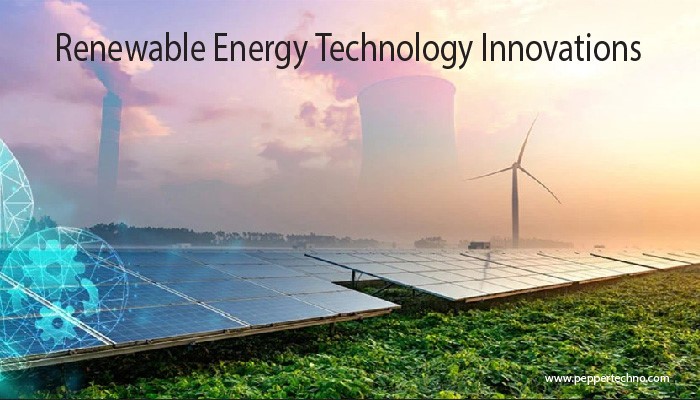Renewable Energy Technology Innovations: Complete Overview
Welcome to the exciting world of renewable energy technology innovations! As our planet faces increasing challenges from climate change and environmental degradation, the importance of transitioning to sustainable energy sources has never been more pressing. In this blog post, we will explore the latest advancements in renewable energy technologies that are revolutionizing the way we power our world. From solar power to wind energy, hydroelectricity to biomass, geothermal to bioenergy – get ready to dive into a realm of innovation and possibility as we discover how these cutting-edge technologies are shaping the future of clean energy solutions. Let’s embark on a journey towards a greener and more sustainable tomorrow together!

The Advantages of Using Renewable Energy
Renewable energy offers a myriad of advantages that make it a sustainable and eco-friendly alternative to traditional fossil fuels. One of the key benefits is its abundant availability, as sources like sunlight, wind, water, and organic matter are replenished naturally. This accessibility reduces reliance on finite resources and helps mitigate the impact of climate change.
Using renewable energy also promotes energy independence by diversifying the power supply and reducing dependence on imported fuels. It boosts local economies through job creation in industries such as solar panel manufacturing, wind turbine installation, and biomass production. Additionally, these technologies have lower operating costs and can provide long-term stability against fluctuating fuel prices.
Furthermore, renewable energy systems produce minimal greenhouse gas emissions compared to fossil fuels – contributing significantly to reducing air pollution and improving public health. They also have a smaller environmental footprint overall, preserving ecosystems and biodiversity for future generations to enjoy.
Latest Innovations in Solar Power Technology
Solar power technology has been rapidly evolving, bringing about exciting innovations in recent years. One of the latest advancements is the development of solar skin technology, which integrates photovoltaic cells into building materials like windows and roof tiles. This innovation allows for seamless integration of solar panels into the design of structures without compromising aesthetics.
Another breakthrough in solar energy is the use of perovskite solar cells, which have shown great potential for increased efficiency and lower production costs compared to traditional silicon-based cells. These lightweight and flexible cells can be easily incorporated into various applications, making them a promising option for future solar installations.
Moreover, floating solar farms are gaining popularity as they utilize unused water surfaces such as reservoirs or dams to generate clean energy efficiently. By harnessing sunlight over bodies of water, these floating arrays not only produce electricity but also help reduce evaporation rates.
In addition to these innovations, researchers are exploring the concept of transparent solar panels that can be integrated into windows or screens without obstructing views while still generating electricity. With ongoing developments in the field of solar power technology, we can expect even more groundbreaking solutions to emerge in the near future.
Wind Energy and its Technological Advancements
Wind energy has been a game-changer in the renewable energy sector, harnessing the power of the wind to generate electricity. With technological advancements, wind turbines have become more efficient and cost-effective, making them a viable alternative to traditional fossil fuels.
One significant innovation is the development of larger and more powerful wind turbines that can capture even more energy from the wind. These massive structures can now reach heights taller than skyscrapers, taking advantage of stronger winds at higher altitudes.
Moreover, improvements in turbine design and blade technology have increased efficiency while reducing maintenance costs. Advanced monitoring systems allow for real-time data analysis to optimize performance and ensure reliability.
In addition to onshore wind farms, offshore installations are gaining popularity due to their potential for higher wind speeds and less visual impact on land. Floating turbines represent a cutting-edge solution for generating clean energy in deep waters.
These technological advancements in wind energy continue to drive its growth as a key player in the transition towards a sustainable future.
Hydroelectricity and its Growing Potential
Hydroelectricity, a renewable energy source that harnesses the power of flowing water to generate electricity, has been gaining momentum in recent years. With advancements in technology, hydroelectric power plants are becoming more efficient and cost-effective. The ability to control water flow through dams allows for consistent energy production without relying on external factors like sunlight or wind.
One of the key advantages of hydroelectricity is its reliability as a baseload power source. Unlike solar or wind energy, which can be intermittent depending on weather conditions, hydroelectric plants can provide a stable supply of electricity around the clock. This makes it an essential component in countries striving to reduce their dependence on fossil fuels and decrease carbon emissions.
As concerns about climate change continue to grow, the potential for expanding hydroelectric capacity becomes even more significant. By tapping into this clean and sustainable energy source, nations can work towards achieving their renewable energy goals while minimizing environmental impact. The future looks promising for hydroelectricity as innovations pave the way for increased efficiency and scalability in harnessing hydropower resources.
Biomass and Bioenergy Innovations
Biomass and bioenergy innovations are revolutionizing the way we harness renewable energy. Biomass, derived from organic materials like wood, crops, and waste, is being increasingly used to produce bioenergy in a sustainable manner. One exciting development is the use of advanced technologies to convert biomass into biogas or biofuels.
Researchers are exploring ways to enhance the efficiency of biomass conversion processes, making them more cost-effective and environmentally friendly. By utilizing innovative techniques such as gasification and pyrolysis, biomass can be transformed into valuable sources of clean energy.
Bioenergy innovations extend beyond power generation; they also play a crucial role in reducing greenhouse gas emissions and promoting a circular economy. With continuous advancements in biorefinery technology, we can expect to see even greater utilization of biomass resources for energy production in the near future.
Emerging Technologies in Geothermal Energy
Geothermal energy is a sustainable and reliable source of power that harnesses heat from beneath the Earth’s surface. Recent technological advancements are making this renewable energy option even more promising.
One of the emerging technologies in geothermal energy is Enhanced Geothermal Systems (EGS), which involves creating artificial reservoirs by injecting water into hot rock formations deep underground to generate steam for electricity production.
Another innovation is utilizing closed-loop geothermal systems, where a network of pipes circulates a heat transfer fluid through the ground to extract heat for heating buildings or generating electricity.
Furthermore, researchers are exploring new drilling techniques and materials to improve efficiency and reduce costs associated with geothermal energy extraction.
These innovative technologies have the potential to expand geothermal energy production globally, contributing to a cleaner and more sustainable future.
Challenges and Limitations of Renewable Energy Technology
As the world increasingly turns towards renewable energy sources, it is essential to be aware of the challenges and limitations that come with these technologies. One significant issue is the intermittency of renewable energy generation, as sunlight, wind, and water availability can vary. This unpredictability poses a challenge for maintaining a stable power supply.
Another obstacle is the high initial costs associated with setting up renewable energy infrastructure. While these costs have been decreasing over time, they still present a barrier to widespread adoption. Additionally, integrating renewable energy into existing grids can be complex due to differences in infrastructure and capacity.
Storage technology also remains a limitation for renewables. Developing efficient and cost-effective storage solutions is crucial for ensuring continuous power supply during periods when natural resources are scarce.
Regulatory hurdles and public acceptance are other challenges that need to be addressed for renewables to reach their full potential. Overcoming these obstacles will require collaboration between governments, industries, and communities worldwide.
The Future of Renewable Energy
As we look ahead to the future of renewable energy, the possibilities are endless. With ongoing advancements in technology and growing awareness of environmental issues, the trajectory for renewable energy is promising.
Innovations in solar power, wind energy, hydroelectricity, biomass, bioenergy, and geothermal systems continue to push boundaries and expand capabilities. These developments not only improve efficiency but also make renewable sources more accessible and cost-effective.
The integration of smart grids and energy storage solutions further enhances the reliability and stability of renewable energy sources. As we move towards a more sustainable future, collaboration between governments, industries, and communities will be crucial in accelerating the adoption of clean energy technologies.
The transition to a predominantly renewables-based energy system is within reach. The shift towards cleaner alternatives not only reduces carbon emissions but also fosters economic growth and job creation in the green sector. The future of renewable energy is bright – it’s up to us to embrace these innovations wholeheartedly for a greener tomorrow.
Conclusion:
In embracing renewable energy technology innovations, we are not only investing in a sustainable future but also paving the way for a cleaner and greener world. The advancements in solar power, wind energy, hydroelectricity, biomass, bioenergy, geothermal energy, and other renewable sources are reshaping the way we produce and consume energy.
Despite facing challenges and limitations such as intermittency and high initial costs, the potential of renewable energy is undeniable. With continuous research and development efforts focused on enhancing efficiency and reducing costs, the future of renewable energy looks promising.
As we move towards a more sustainable energy landscape driven by innovation and technological progress, it is crucial to support policies that promote the widespread adoption of renewables. By harnessing the power of nature’s resources responsibly, we can create a brighter tomorrow for generations to come.
Let’s continue to explore new possibilities in renewable energy technology innovations and work together towards building a cleaner, healthier planet for all.



